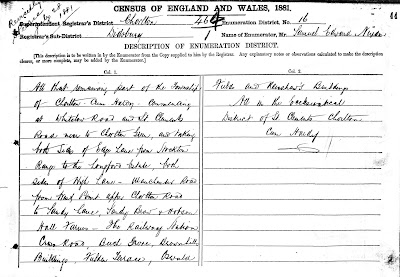It’s that time of year again, or to be more accurate that time that falls once every ten years and is the census.
 |
| 2021 |
Despite having been born in the first half of the last century, the first one I filled in was 1981, followed by only three more.
So, this year later in the month having slipped effortlessly passed my 71st birthday I will complete number 5.
The first two will have been filled in by Dad, and the 1971 may have been the responsibility of Miss Finn in whose house I was temporarily living as a student on Rippingham Road in Withington, or perhaps dad again, given that I might have been home from College.
But this one, the 2021st will be odd, because not only will none of our 4 sons appear on it at our address, but they will be completing their own, which of course makes me feel a tad old.
Added to which I will be again filling it in online, making only three returns completed in the old fashioned way with a pen and paper.
There will be some who moan at the exercise, and others who object on the basis of some deep mistrust of where the data will go, but not me.
For the last fifteen years I have wandered over past census records, looking for my family and then part of that regular activity of finding out about the past from the documents people have filled in.
And the census is an invaluable window on how we lived in the past, allowing the historian, the student of family history and the curious to explore how people earned their living, to what extent their homes might be judged overcrowded, and the degree to which the population was moving around the country.
The first census was 1801, but thirty years later the 1841 offered up the details of names, places of birth, and occupations, making it possible to build up a picture of an individual street, hamlet, or village.
Over the following decades more information was recorded, ending at present with the 1911 census which recorded how long a couple had been married, the total number of children they had, including those that died, as well as the number of rooms in the property.
All of which makes it possible to track an individual across time, and discover whether they prospered, moved around the country, or fell on hard times and ended in the Workhouse or prison.
 |
| 1881 |
The draw back is that 10 years between each census is a long time and you can lose people, or for some reason they are not where they should be on the magic night and are left off.
Added to which some returns have been damaged to the point where the entries are very difficult to read.
But they are a start, and can be used in conjunction with street directories which were published each year and newspaper reports and other documents.
And the there are the unintended snippets, which offer up insights into the past.
So, the 1841 and 1851 census returns were completed at different times of the year and in agricultural communities this can show that some farm workers were engaged in different occupations reflecting the changing seasons.
While in 1911 some women chose to complete the return, filling in the space for occupation with the word Suffragette.
All of which means I will be happy to complete my return, although of course I will never get to use it for research.
Picture; census 2021,, and front to Enu 16, Chorlton-cum-Hardy, 1881
No comments:
Post a Comment